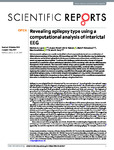Revealing epilepsy type using a computational analysis of interictal EEG
| dc.contributor.author | Lopes, MA | |
| dc.contributor.author | Perani, S | |
| dc.contributor.author | Yaakub, SN | |
| dc.contributor.author | Richardson, MP | |
| dc.contributor.author | Goodfellow, M | |
| dc.contributor.author | Terry, JR | |
| dc.date.accessioned | 2023-02-20T13:05:14Z | |
| dc.date.issued | 2019 | |
| dc.identifier.issn | 2045-2322 | |
| dc.identifier.issn | 2045-2322 | |
| dc.identifier.other | 10169 | |
| dc.identifier.uri | http://hdl.handle.net/10026.1/20470 | |
| dc.description.abstract |
<jats:title>Abstract</jats:title><jats:p>Seizure onset in epilepsy can usually be classified as focal or generalized, based on a combination of clinical phenomenology of the seizures, EEG recordings and MRI. This classification may be challenging when seizures and interictal epileptiform discharges are infrequent or discordant, and MRI does not reveal any apparent abnormalities. To address this challenge, we introduce the concept of <jats:italic>Ictogenic Spread</jats:italic> (IS) as a prediction of how pathological electrical activity associated with seizures will propagate throughout a brain network. This measure is defined using a person-specific computer representation of the functional network of the brain, constructed from interictal EEG, combined with a computer model of the transition from background to seizure-like activity within nodes of a distributed network. Applying this method to a dataset comprising scalp EEG from 38 people with epilepsy (17 with genetic generalized epilepsy (GGE), 21 with mesial temporal lobe epilepsy (mTLE)), we find that people with GGE display a higher IS in comparison to those with mTLE. We propose IS as a candidate computational biomarker to classify focal and generalized epilepsy using interictal EEG.</jats:p> | |
| dc.format.extent | 10169- | |
| dc.format.medium | Electronic | |
| dc.language | en | |
| dc.language.iso | eng | |
| dc.publisher | Springer Science and Business Media LLC | |
| dc.subject | Adult | |
| dc.subject | Brain | |
| dc.subject | Computational Biology | |
| dc.subject | Electroencephalography | |
| dc.subject | Epilepsies, Partial | |
| dc.subject | Epilepsy | |
| dc.subject | Epilepsy, Generalized | |
| dc.subject | Female | |
| dc.subject | Humans | |
| dc.subject | Magnetic Resonance Imaging | |
| dc.subject | Male | |
| dc.subject | Seizures | |
| dc.title | Revealing epilepsy type using a computational analysis of interictal EEG | |
| dc.type | journal-article | |
| dc.type | Article | |
| plymouth.author-url | https://www.ncbi.nlm.nih.gov/pubmed/31308412 | |
| plymouth.issue | 1 | |
| plymouth.volume | 9 | |
| plymouth.publication-status | Published online | |
| plymouth.journal | Scientific Reports | |
| dc.identifier.doi | 10.1038/s41598-019-46633-7 | |
| plymouth.organisational-group | /Plymouth | |
| plymouth.organisational-group | /Plymouth/Faculty of Health | |
| plymouth.organisational-group | /Plymouth/Faculty of Health/School of Psychology | |
| plymouth.organisational-group | /Plymouth/Users by role | |
| plymouth.organisational-group | /Plymouth/Users by role/Academics | |
| dc.publisher.place | England | |
| dcterms.dateAccepted | 2019-07-02 | |
| dc.rights.embargodate | 2023-2-21 | |
| dc.identifier.eissn | 2045-2322 | |
| dc.rights.embargoperiod | Not known | |
| rioxxterms.versionofrecord | 10.1038/s41598-019-46633-7 | |
| rioxxterms.licenseref.uri | http://www.rioxx.net/licenses/all-rights-reserved | |
| rioxxterms.licenseref.startdate | 2019-07-15 | |
| rioxxterms.type | Journal Article/Review |


